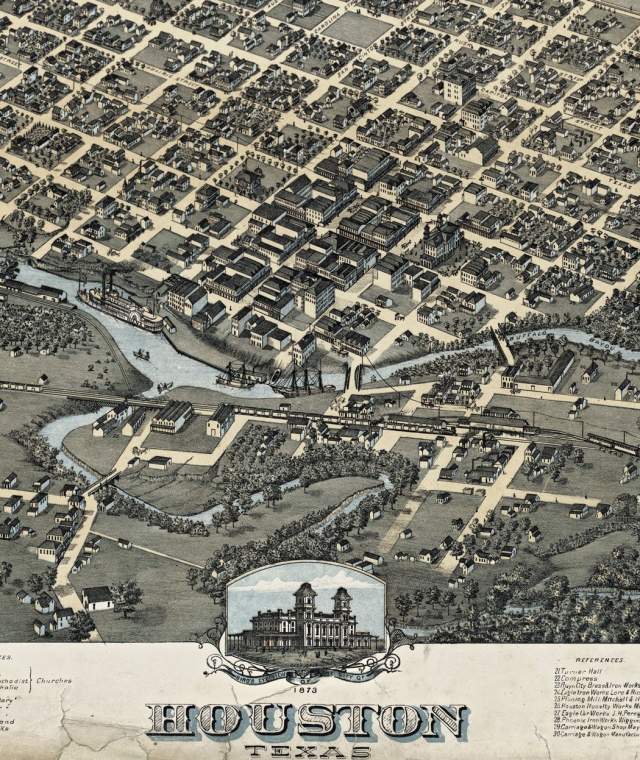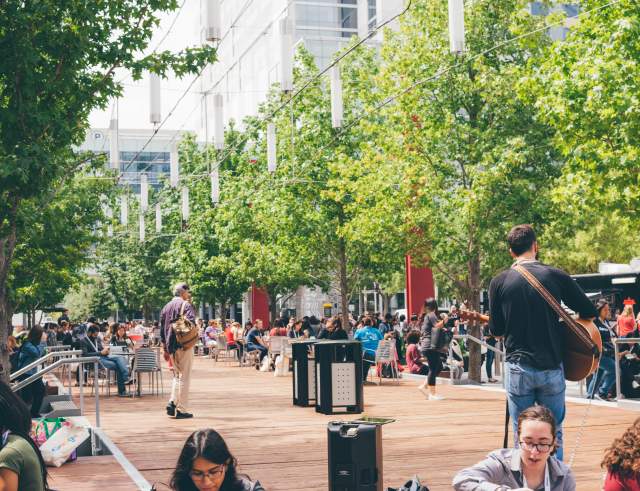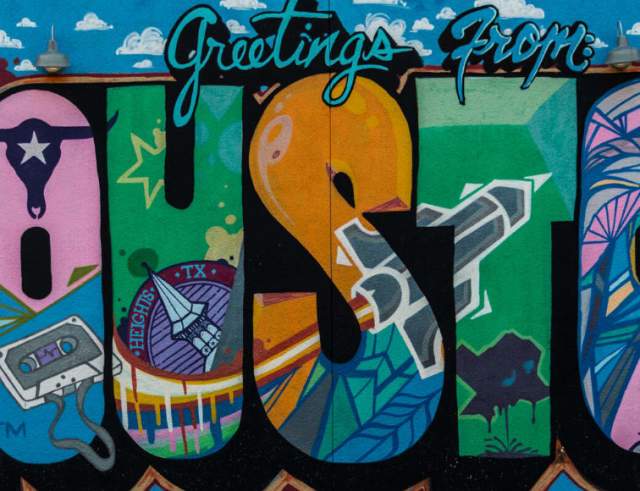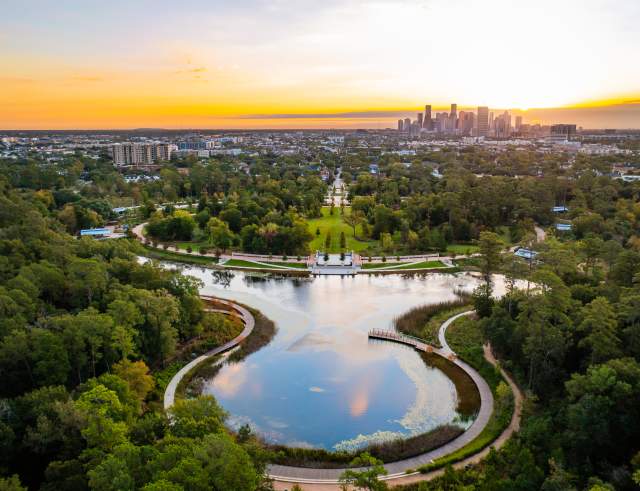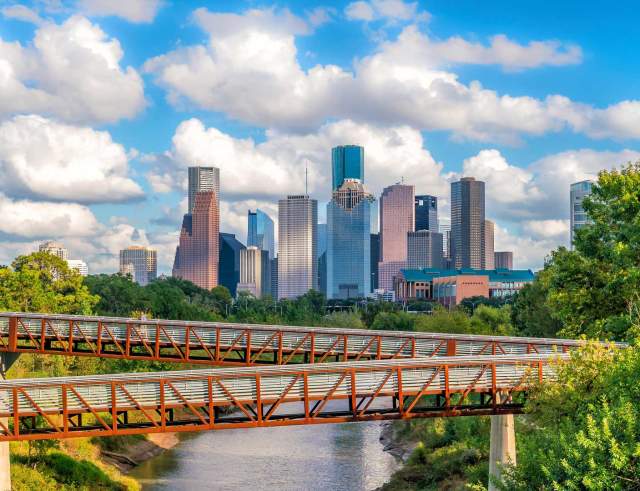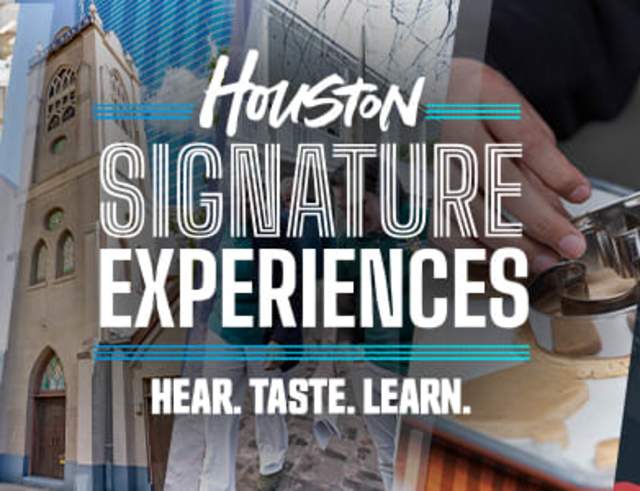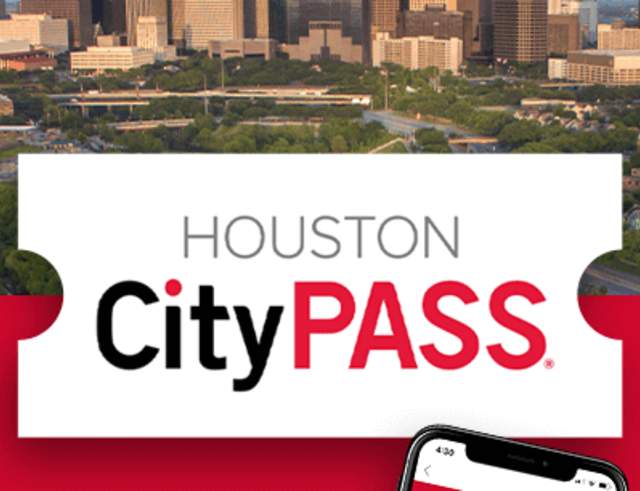History
A city evolves
The flat land was easy to subdivide, and the Allens made a killing selling lots. But Houston soon lost its standing as state capital. In 1839 Mirabeau Buonaparte Lamar, who succeeded Sam Houston as Texas president, moved the capital to yet another town, Waterloo in the Texas Hill Country. It was soon renamed Austin in honor of the "father of our country."
Houston was an entrepreneurial place from the moment of its founding. In 1832 two brothers from new York State, John K. Allen, a shopkeeper and dreamer, and his brother Augustus, a bookkeeper and a pragmatist, joined hundreds of Americans who gobbled up cheap scrip offered by Galveston Land Company and authorized by Mexico. It conveyed the right to settle the wide-open Mexican state of Coahuila-Texas. The Allens headed for Nacogdoches, a town of intrigue on the border between Mexican Texas and American Louisiana, where talk of revolution against Mexico fermented.
They befriended Sam Houston, a giant of a man who had served as Tennessee governor and a U.S. congressman before he countrified and rode to Texas to stir up trouble on behalf of President Andrew Jackson. That unrest would explode into rebellion and the nitrous slaughter of William Travis, Jim Bowie, Davy Crockett and about 140 other men at the Alamo in San Antonio in late February and early March 1836. A month later on the San Jacinto River in East Texas, Houston wreaked revenge, leading Texas forces to kill more than six hundred Mexican troops and capturing their commander, General Antonio Lopez de Santa Anna.
With victory came independence for the rough-hewn Republic of Texas. The Allen brothers, who had been busy scouting for land on which to build a speculative city, purchased 6,642 acres along the west bank of Buffalo Bayou, a muddy, meandering stream that lolled southward to the bustling port of Galveston.

Houston Main St. 1856
Every nation needs a capital, the Allens realized. Why not this barren place they had grandly named in honor of their friend? They even built a two-story, wooden capitol building to house a government. Sure enough, in April 1837 the new Texas Congress moved from Columbia to this muddy frontier town. The coastal prairie was soon dotted with log cabins, taverns, and shacks passing for shops-but mostly lean-tos and crude tents-so anxious were people to get a foothold in this wild and wooly place. A theater went up in a matter of weeks, but it was three years before Houston saw its first church.
To everyone's surprise, Houston flourished anyway. Freight wagons and railroad from the fertile Brazos River country converged on the little town, carrying cotton and hides bound for Galveston. Before long, the chamber of commerce began advertising Houston as the place "where 17 railroads meet the sea." Never mind that the Gulf of Mexico was 50 miles away. The first automobile, proudly purchased by the Houston Left Hand Fishing Club, sputtered into town in 1901. Air passenger service would arrive with a Braniff Airlines flight in 1935. Houston did indeed become the Texas capital - of commerce. So fast would it grow, in such scintillating fashion and with such a profusion of ideas, dreams, wealth and schemes, that one astonished observer dubbed it "Babylon on the Bayou."
From the moment a steamboat first made its way up the Buffalo Bayou to Houston in 1844, city burghers magnanimously dubbed their humble docks the "Port of Houston." The community's business leaders besought the U.S. Congress to pay for widening and deepening the bayou so it could truly become a deep-water channel. In 1910 they won the day, after promising to foot half the bill. Four years later, just in time to profit from the war in Europe, the 36-foot-deep Houston Ship Channel was completed, leading into a huge turning basin in the old town of Harrisburg, by then a part of fast-growing Houston on the east.

The Port of Houston quickly prospered, in part through the misfortune of rival Galveston, which had been devastated by the killer hurricane of 1900. At the time, Galveston boasted the nation's second largest per capita number of millionaires, virtually all of whom made their fortunes in shipping. Galveston dallied in rebuilding its port and when it did, it found that it had lost much of its business to the upstart port upstream. Houston dangled cheaper prices, abundant fresh water, and before long, docks and refineries protected from the direct brunt of gulf storms. By 1930 Houston's port facilities at the end of what folks in town called "our little ditch" had already become the nation's eighth largest.
Prosperity for the Port of Houston and the rawboned town as a whole was assured after 1901. In that year, the monumental Spindletop gusher blew at Gladys City near Beaumont. Soon wooden derricks filled the prairies of East Texas, fortunes were made and lost and oil refineries sprang up along the Houston Ship Channel feeding the nation's insatiable appetite for gasoline and oil. Giant oil companies set up shop in Houston, sophisticated chemical operations evolved and the World's Energy Capital was born.
Houston's shipbuilding, oil production, and steel manufacturing were critical contributors on the home front during World War II. These were the days of idiosyncratic giants such as "Mr. Houston" Jesse Jones, a lumberman-turned-banker who financed a skyscraper a year in downtown Houston and hosted a weekly high-stakes poker game in suite 8F at the Lamar Hotel. More than once, Jones would start the game by announcing, "Boys the United Way drive (or another worthy undertaking) is running a little behind. All the money we bet here tonight goes to the united way, and it costs $5,000 to get in." Each player would write a check for $5,000 before the first deal.
Houston nurtured other legendary figures as well. There was Will Clayton, who had been president of the world's largest cotton company. Soon after he took office as the nation's first undersecretary of state for economic affairs in 1946, he wrote a long memorandum proposing massive aid for war-ravaged Europe; the memo inspired much of the language of a June 6, 1947 speech by his boss, Secretary of State George C. Marshall, that heralded the sweeping Marshall Plan to rescue Europe.
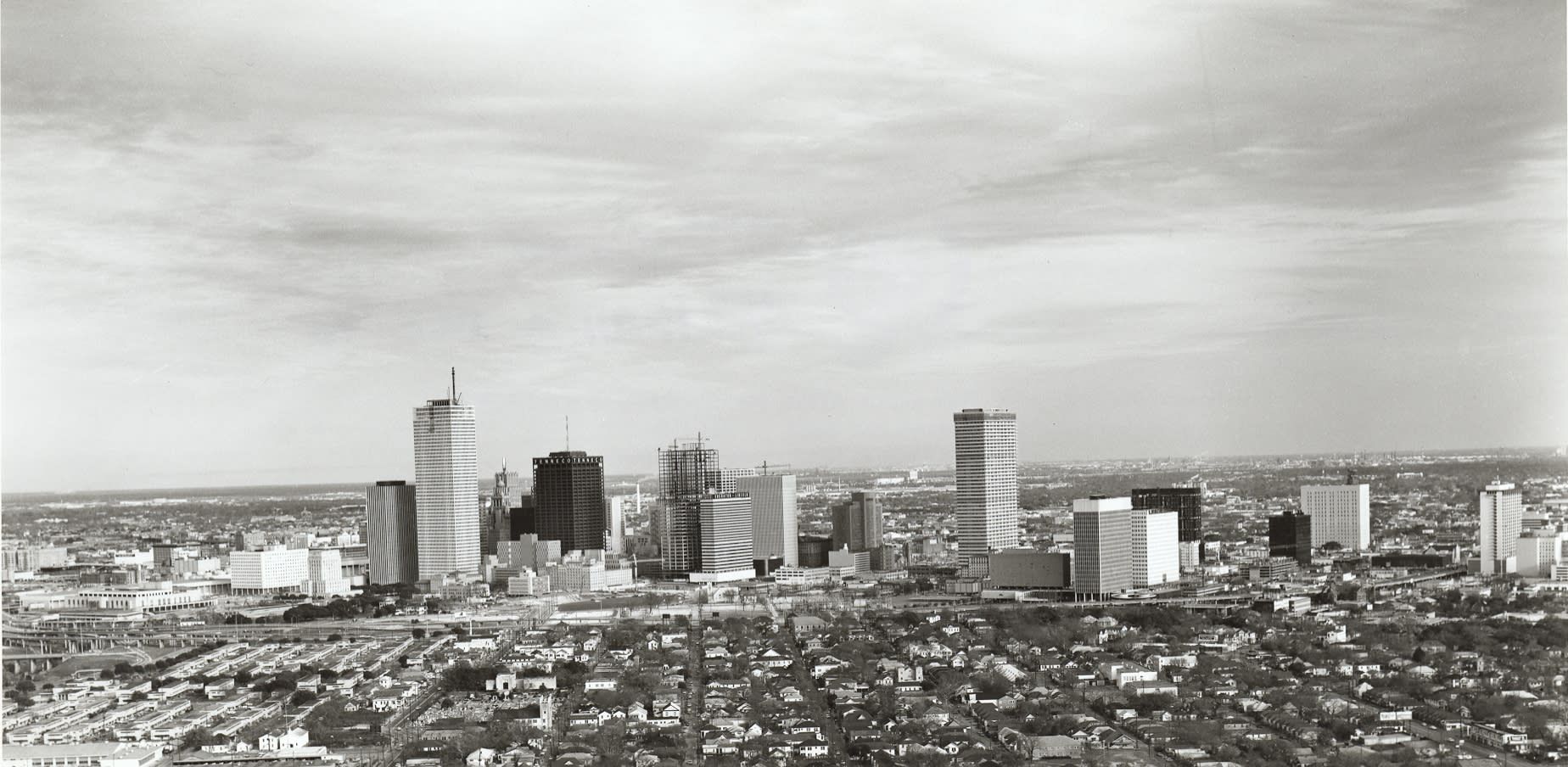
Roy Hofheinz was a page in one of Jesse Jones's hotels. As a cantankerous mayor in the 1950s the former Harris County judge fought constantly with the city council and was nearly impeached. But his administration refurnished downtown and in 1965, as head of the Houston Sports Commission, he brought the city the "eighth Wonder of the Modern World," the 76,000-seat Astrodome, the first gigantic, domed baseball and football stadium.
Sophistication, incredible generosity and civic selflessness permeated the coarse commercialism of the emerging megalopolis on the East Texas plain. A prime example is the altruism of M.D. Anderson, an assiduous partner with Will Clayton in Houston's biggest cotton brokerage. When Anderson, a bachelor who lived alone in a downtown hotel, died in 1939, he left most of his substantial fortune to a foundation to be dedicated in part to hospitals "for the care of the sick, the young, the aged, the incompetent and the helpless among the people." Three years later his executors approved the expenditure of funds to locate the University of Texas' new cancer treatment center, named for Anderson in Houston.
Soon Baylor University would move its medical school from Dallas to the budding medical center complex. Combined with the existing Memorial Hermann Hospital on the city's new outer belt road, and the Texas Dental College, the M.D. Anderson Hospital and Baylor College of Medicine formed the core of the revolutionary Texas Medical Center, now more than 40 independent institutions in 100 buildings on 670 acres in the world's largest medical center complex.
Excerpts from the book Houston, Deep in the Heart by Carol M. Highsmith and Ted Landphair
An Abbreviated Timeline
1836
Brothers Augustus Chapman Allen and John Kirby Allen found Houston
1845
Texas becomes the 28th state in the Union
1870
Congress designates Houston a port
1899
Houston's first park opens. The site, now Sam Houston Park, contains several of Houston's earliest buildings
1948
Voters first reject proposed zoning ordinance. It's rejected again in 1962 and 1993.
1932
First Houston Livestock Show and Rodeo held
1943
Texas Medical Center founded
1947
Alley Theatre established
1969
"Houston" is first word spoken from the lunar surface
1971
Shell Oil Co. relocates corporate headquarters to Houston. More than 200 major firms move headquarters, subsidiaries and divisions here in the years following.
2000
Census finds Houston MSA has no racial or ethnic majority
2004
First modern light rail line-7.5 miles-begins operations.
As the nation's fourth-largest city, Houston at the dawn of the 21st Century is a melting pot of peoples and cultures, a dynamic community of world-class art, entertainment, food and attractions.The city's geographic location on the Gulf Coast and superb airport system make it a gateway to Latin America and the world beyond. A diverse economy, coupled with a "can do" attitude has made Houston a prime destination for entrepreneurs and those looking for new opportunities.
More About Houston
Neighborhoods
Like many major cities, Houston is defined by its neighborhoods. You can cross a street and walk…
Texas Medical Center
The Texas Medical Center is the largest life sciences destination in the world. With 106,000…
Colleges & Universities
Learn about the colleges and universities in the Houston area. Find information on our 14 major…
Houston in the News
Citing Houston's strong culinary and cultural landscape, some of the country's top…
Sister Cities
With one of the largest foreign-born populations in the U.S., significant business ties around the…
Nearby Towns
The southeast Texas region is home to many historic sites, natural escapes, and vibrant communities…
My Houston Toolkit
The My Houston Toolkit gives you the tools and resources you need to sell the cultural and culinary…
Experience Houston
Houston Signature Experiences
Houston's rich tapestry of history, culture and stories are vividly brought to life in a collection…
Air, Land, Sea & Space Pass
Take advantage of a one-of-a-kind pass that combines the best experiences Houston as the offer…
Houston CityPASS
Save 50% on admission to Houston’s top 5 attractions with CityPASS tickets.
Houston Brew Passes
Sip your way through Houston and taste new flavors and discounted beer flights from your favorite…
What's Trending
Things To Do
Guide to Healthy Fast Food in Houston
- 4 minute read
Houston, known for its culinary excellence and diverse dining options, is at the forefront of a culinary revolution: healthy fast food. The…
Read More

